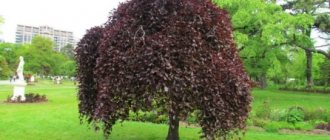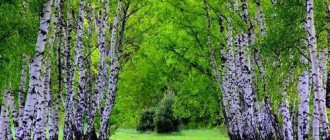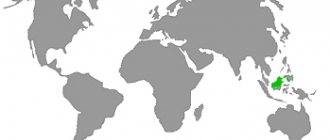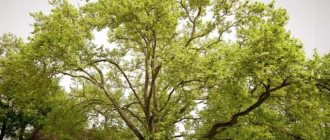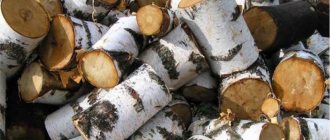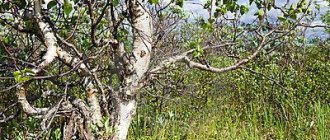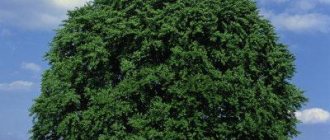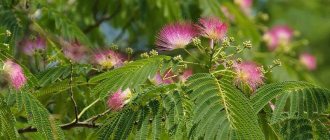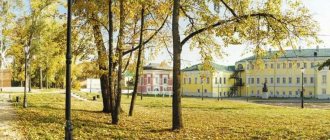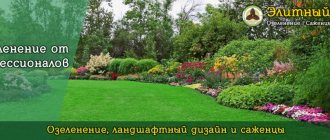When you hear the word “birch”, small green leaves, white thin trunks, quivering and weightless groves, completely penetrated by the sun, immediately appear before everyone’s eyes. But all this has little to do with Schmidt’s birch. It turns out that birch is a whole genus of deciduous trees, which includes more than a hundred species. So what does Schmidt birch look like and what unique features does its wood have?
Name
Betula schmidtii is the name in Latin for this representative of the Birch genus from the birch family. The Russian name, Schmidt's birch, is associated with the name of a famous botanist who discovered and described an interesting species. But some people don't set out to remember scientific names. They use the most memorable feature of the plant, by which it is most easily recognized. A better known name is ironwood, or iron birch.
Meaning, application
This tree with amazing features has become widely used in green construction in the form of a valuable decorative species when planted in parks, forest parks, on the edges and clearings of forests. In tandem with oak, it can be planted in a protective strip. The characteristics of Schmidt birch are also determined by its beauty and simplicity. A tree that provides through shade is a decoration for a rural look in summer and winter and is very popular. Since ancient times, people have sung about the birch tree; it has been and remains a symbol of beauty.
Technological features of Schmidt birch: it can be polished well and can be processed with cutting tools. This tree is used for the manufacture of artistic products, as plywood raw material and in mechanical engineering.
This tree is also used in medicine. Both buds and birch leaves are used for medicinal purposes.
When treating influenza, you can take two tablespoons of infusion from birch buds and leaves orally four times a day. To prepare it, brew 1 tablespoon of raw material in a glass of boiling water.
Use of iron birch for chronic fatigue syndrome: take a tablespoon of buds per glass of boiling water, heat for half an hour in an enamel bowl in a water bath, strain, squeeze and add boiling water to the original volume.
Characteristics of the species
Schmidt birch is a weakly branched deciduous tree, the height of which exceeds 20 m. Individual specimens can grow up to 30 m. The bark of the trunk has a brownish-gray or cream color. The trunk itself is covered with cracks, and in places the bark is peeling and peeling off. But on the branches it is smooth, colored dark cherry, brown or black. Resinous glands appear along the bark of the branches; people call them “lentils.”
Schmidt's birch, a photo of which can be seen in the article, is covered with short-petioled leaves of an elliptical or ovoid shape. The leaf size is approximately 8 cm, it is irregularly jagged along the edge, and pubescent veins are noticeable below. The upper side of the leaf is bare and glossy.
Birch Medvedeva
Grows in Western Transcaucasia. It rises to 2300 m above sea level and forms crooked birch forests at the upper limits of forest vegetation, usually on rocky screes and cliffs of the northern slopes.
A small tree up to 6 m in height with a creeping trunk covered with whitish bark. Rough leathery leaves of different sizes: closer to the lower, older part of the shoot the largest leaves are located, towards the top the leaves become smaller and narrower. It blooms in spring at the same time as the leaves bloom. Fruiting catkins ripen the next year after flowering. At the same time, they crumble and the seeds are scattered by the wind.
The lower part of a birch trunk usually spreads down the slope, strengthened by additional roots. The apical part, arching like a saber, gradually rises 5-6 m above the surface of the earth. At the age of 100-120 years, the trunk begins to die from the base. The death of old parts occurs simultaneously with the growth and rooting of young ones. Thus, thickets of Medvedev birch spread along the slopes, forming large clumps.
In the subalpine crooked forests of Western Transcaucasia, a very similar species also grows - Mingrelian birch, characterized by smaller leaves and fruit catkins.
Both species are very ancient and extremely interesting representatives of the tree flora of the Caucasus, in need of protection as valuable natural monuments. Related species grow only in the mountains of East Asia and in the Atlantic part of North America.
Subalpine birch forests play an important water conservation role and protect slopes from destruction.
Reproduction method
During the flowering period, Schmidt birch is covered with straight, elongated catkins. They have an elongated, slightly curved shape. The length of the birch catkin is 3 cm. At the end of summer or beginning of autumn, the fruits ripen, the size of which is approximately 2 mm. This type of birch reproduces by seeds. The seed fruits are oval in shape and do not have wings to help them fly in the wind. A narrow border edge is adapted for these purposes.
The lifespan of iron birch is more than 350 years. During this time, it produces a huge number of seeds, but only a few of them become young trees. A young tree, no more than 120 years old, can additionally reproduce by stump shoots.
What does it look like
Most Russians are accustomed to believing that birch is distinguished from other trees by its white bark. But the plant we are interested in is not similar to the widespread representatives of its family. The bark of young branches of the Schmidt birch is dark cherry, and on old trunks it is dark gray. And if you separate the surface layer, then underneath you can see areas of brown bark with a bizarre purple tint.
The famous florist and dendrologist Dmitry Vorobyov in the book “Wild-growing trees and shrubs of the Far East” (Leningrad, 1968) writes that the Schmidt birch reaches a height of 20-25 m, and the trunk diameter of old trees is 80 cm. True, the tree has such parameters reaches only at the age of 300-350 years, because it grows very slowly, especially in the first 50 years of its life.
The crown of the old Schmidt birch begins at a height of 8-10 m. The length of its leaves is about 7 cm, the width is from 3 to 5 cm. Moreover, in young plants the leaves are narrower, while in adults they are slightly wider. The tree is propagated by seeds and cuttings; it is successfully cultivated in the botanical gardens of the Far East, St. Petersburg, Moscow and other cities of Russia.
Schmidt birch buds usually open by May 10th. It blooms with earrings until May 20. The seeds ripen in September; they are light brown nuts up to 2 mm in size. By the end of October, the tree completely sheds its foliage.
Experts believe that the Schmidt birch is an ancient relic; it is older than other representatives of its family and grows much longer than ordinary white-trunked beauties.
Features of wood
Do you want to know what else is interesting about Schmidt birch? Its wood is strong, elastic and hard. At the same time, the strength is simply phenomenal! It can be considered the strongest and hardest wood in the world. According to experts, it is almost as dense as backout (the heartwood of guaiac wood). The density of Schmidt iron birch wood is about 1100 kg/m³.
Is Schmidt birch used in the national economy? The peculiarity of wood made it indispensable in the manufacture of some household tools, especially at a time when metal tools were not available to everyone. Mortars, rollers and flails for threshing grain were made from unique birch. She went to the cart axles.
Iron birch wood was used in the weaving industry. For example, machine shuttles were made from it. When making this part from other types of wood, the shuttles quickly wore out and lost their shape.
Despite its unique strength, Schmidt birch is almost never used in shipping. Of course, parts and pieces of ships would not be subject to deformation and rot, but wood of this type has a high specific gravity and sinks in water. Although this tree is sometimes used for small details.
Large-leaved birch
It is found in central and southern Yakutia, reaching in the south almost to the Amur region.
A large-leaved tree with a winding, low white-pink trunk with black-brown branches covered with lentils. The leaves are leathery, similar to poplar, dark green, up to 10-12 cm long and about the same width, rounded, ovate, with a pointed apex, glabrous on both sides, slightly sticky. Catkins and ovoid nuts with relatively wide wings are larger in size than those of other birch species.
Very little studied, but well worthy of widespread testing in landscaping.
Unusual experiments
The strength of Schmidt birch wood was proven in a simple way. To do this, they shot into the tree trunk with a gun. The bullet bounced like a ball without damaging the barrel. Another proof of its strength is the fallen trees. If during storms and hurricane winds the Schmidt birch fell, then its trunk could lie for several decades. Only the top layer of bark deteriorated, and the wood itself did not rot.
As an experiment, in 1932, Sovtorgflot made bearings for a steam engine from Schmidt birch for one of its boats. The exact operating time of the experimental parts was not established, but they lasted no less than their metal counterparts.
Fluffy birch
It grows in forests throughout the European part of Russia in the Caucasus, Western and Eastern Siberia, Scandinavia, Western Europe. Over a vast area, downy birch grows together with weeping birch.
Downy birch often forms hybrid forms with weeping birch. In hybrids, the characteristics of both species are often so mixed up that even forest botanists sometimes find it difficult to decide which species to classify this or that tree. However, downy birch tolerates marshy and cold soils well, so it goes further north than weeping birch, but in the steppe zone and on dry soils it gives way to it.
Tree up to 20-25 m in height. The bark is white, unlike the bark of the weeping birch, it cracks very little at the base of the trunk. The crown is not weeping, since the ends of the branches do not droop. Young shoots and leaves (usually with a rounded base) are densely pubescent and free of warts.
The Litvinov birch, growing in the Caucasus mountains, is, in a number of ways, a transitional species between downy and weeping birches: the leaves are pubescent on the underside, but have a wedge-shaped base, and there are rare warts on young branches. Litvinov's birch has more leathery leaves than both of these types of birch. Together with the weeping birch it forms a belt of birch forests at an altitude of 1500 to 2000 m above sea level; higher up it grows with pine, and in the subalpine zone it forms open forest together with mountain ash, raspberry, and alpine maple.
Protected species
A tree whose wood is so unique could not but arouse increased interest. This led to uncontrolled cuttings, which significantly reduced the number of plants. The only thing that saved the birch from complete destruction was the fact that it is very difficult to cut down. An ordinary ax is useless for these purposes. It is difficult to restore the number of Schmidt birch. Despite its long lifespan, the tree grows very slowly. Today, Schmidt birch is considered a rare species and is listed in the Red Book. Its logging is completely prohibited and is punishable by law.
Dwarf birch
It forms continuous thickets in the tundra, grows in moss swamps of the forest zone, in the alpine belt of the mountains of Western Europe and in Western Siberia.
Low shrub up to 1 m in height. Young, strongly branched, velvety shoots with dark brown bark bear rounded, bluntly jagged leaves along the edge, the size of a two-kopeck coin. The leaves are glossy on top, the underside is paler. Young leaves are usually sticky.
In the north it is used as fuel, the leaves and branches serve as food for deer in the summer.
A closely related species, the lean birch, differs from the dwarf birch only in its glandular shoots. It grows in Eastern Siberia and the Far East in the tundra, in mossy taiga swamps and on loaches, forming continuous thickets.
Subtleties of cultivation
Schmidt's birch, like other representatives of the genus, is light-loving, but tolerates shaded areas. When there is insufficient lighting, tree trunks bend strongly, so the plants are drawn towards sunlight. The crop does not have any special requirements for soil composition. It is desirable that the soils be loose, slightly acidic or neutral, well moistened, with a high content of humus. The close occurrence of groundwater will benefit the plants. They develop normally on solonetzes, rich chernozems, sands, heavy loams and even on poor podzolic soils, but provided that optimal moisture is ensured. Schmidt birch is propagated by seeds and green cuttings. Seed germination is 65%, rooting of cuttings is 35%. It is recommended to purchase seedlings of the species in question only in nurseries. Planting is done together with a lump of earth. Planting with an open root system is dangerous; sometimes even large and well-developed seedlings do not take root and eventually die. Planting holes are filled with a substrate consisting of garden soil, sand, peat and humus (2:1:1:1). Complex mineral fertilizer is also added to the soil mixture. During autumn planting, phosphorus-potassium fertilizers are added to the mixture. Planting is best done away from buildings, asphalt and paved paths; this is due to the structure of the root system, which over time can damage communications and even the foundation. The main task of care is protection from pests. The most dangerous are May beetles and their larvae, thrips, silkworms, borers and leaf sawflies. Some of them may eat the leaves bare. If pests are detected on trees, leaves are removed and treated with chemicals. Most often, uninvited guests settle on old or young trees. For preventive purposes, plants are regularly sprayed with insecticides and fungicides.
Doesn't burn in fire
Schmidt birch is distinguished by a number of unique features. For example, it is very fire resistant. Sometimes, after devastating forest fires, residents of Primorye observed the following picture: pines and firs burned like matches, while iron birch managed to survive. And all thanks to the increased density of its wood, which, according to experts, varies from 1048 to 1100 kg per cubic meter.
In addition, Schmidt birch is almost not subject to rotting. The trunks of this tree can lie on the ground for several decades completely undamaged. In this case, only the bark will rot.
Thanks to all its unique properties, Schmidt birch wood has always been highly valued on the international market. And since this tree grows very slowly, it is not surprising that by the beginning of the 20th century. scientists sounded the alarm. The Kedrovaya Pad Nature Reserve was established in 1916 precisely to protect the unique flora of the Far East.
Doctor of Agricultural Sciences Gennady Gukov and Candidate of Biological Sciences Natalya Rozlomiy jointly wrote the article “Schmidt Birch (Betula Schmidtii Regel) in the Primorsky Territory: origin, distribution, economic significance.” This work was included in the collection of the V All-Russian Scientific Conference “The Role of Agrarian Science in the Sustainable Development of Rural Territories” (Novosibirsk, 2022). Scientists believe that due to the value of its wood, “this birch deserves not only protection, but also widespread artificial propagation.”
However, this unique plant has one serious drawback. Its high density makes its wood too heavy for use in shipbuilding. You can’t even build a boat or raft from this material, because it sinks in water just like metal.
Places of growth
The strongest iron tree is most popular in the Kedrovaya Pyad nature reserve in the Primorsky Territory. The species of this birch is protected and listed in the Red Book. Found in China and Japan.
READ Cossack juniper: why do landscape designers love it?
Since ancient times, people have been grateful to this tree and sincerely thank it for its delicate beauty and the gift that helps maintain health.
Tree with a “compact” crown
Silver birch "Fastigiata" has a narrow crown. The tree grows up to twenty meters high. The trunk width is no more than five, as a rule. The branches of the plant are directed upward and have a somewhat spiral growth pattern. A distinctive feature of the crown of this birch variety is its compactness. In autumn, the leaves stay on the tree for quite a long time. The structure of the trunk is similar to warty birch. Fastigiata has a well-developed, fairly powerful root system. This variety is quite wind-resistant. The grafted variety "Fastigiata" grows very quickly. A species tree can act as a rootstock.
Forest is the lungs of the planet
About a third of all land is covered by forests. Plants need light energy to synthesize organic substances. This process is called photosynthesis. Its by-product is oxygen.
Only thanks to plants we can breathe, because... They produce 99% of the oxygen, and only 1% comes from the mantle of our planet. At night, when the process of photosynthesis is impossible, trees and other plants begin to consume oxygen, but they consume it in smaller quantities than they produce.
Oxygen is produced not only by trees, but also by all plants inhabiting our planet, including microscopic algae that form phytoplankton.
Useful material
Birch leaves contain:
- saponins;
- essential oil;
- vitamin C;
- ascorbic acid;
- a nicotinic acid;
- carotene;
- glucosides;
- betulo-retinoic acid;
- triterpene alcohols;
- tannins;
- flavonoids;
- betulalbin resin;
- inositol
Birch buds contain: ascorbic acid, essential oil and saponins, as well as bitterness, phytoncides, grape sugar, resin, tannins.
Birch bark contains betulol (triterpene alcohol), which protects the tree from fungi and due to which the plant has a white color, saponins, glucosides (gaulterin and beta-loside), acids (lilac, protocatechinic, oxybenzoic, vanillic), bitter substance, leu- coanthocyanins, catechins, a small amount of essential oil, resinous and tannin substances.
Tar, which is obtained from birch bark using dry distillation, contains cresols, phenol, guaiacol, and dioxybenzenes.
Birch sap contains sugars - glucose and fructose, protein, malic acid, aromatic and tannin substances, vitamins B and C. In addition, birch sap is rich in mineral microelements and substances such as:
- Sodium;
- Potassium;
- Magnesium;
- Calcium;
- Manganese;
- Aluminum;
- Silicon;
- Iron;
- Copper;
- Titanium;
- Barium;
- Strontium;
- Phosphorus;
- Zirconium;
- Nickel.
